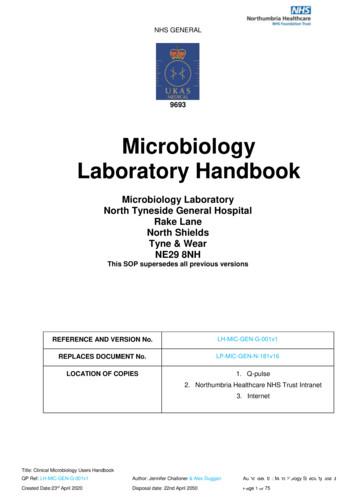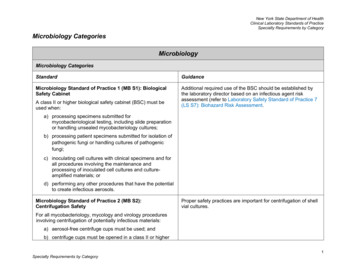Microbiology Lab Safety - University Of Minnesota Duluth
Randall E. HicksThere is a certain element of risk in anything you do, but the potential risks in a microbiology courseare greater. Persons who work in a microbiology lab may handle infectious agents in additional toother hazards such as chemicals and radioactive materials. There have been many documented casesof lab personnel acquiring diseases due to their work. About 20% of these cases have beenattributed to a specific incident, while the rest have been attributed to work practices in the lab. It ispossible that you can be exposed to potentially harmful microbes when you isolate bacteria fromenvironmental materials. So, you should consider environmental samples potentially hazardous anduse BSL2 containment practices (see below). If you are immunocompromised orimmunosuppressed, then you may be at greater risk of acquiring infections in this class than moststudents and should carefully consider whether you should enroll in this course.A microbiology laboratory is a unique environment that requires special practices and containmentfacilities in order to properly protect persons working with microorganisms. Safety in the laboratoryis the primary concern. The three main elements of safe containment of microorganisms are (1)good laboratory practices and technique, (2) safety equipment, and (3) facility design.Microbiology Lab Practices and Safety Rules1. Wash your hands with disinfectant soap when you arrive at the lab and again before you leave.2. Absolutely no food, drinks, chewing gum, or smoking is allowed in the laboratory. Do not putanything in your mouth such as pencils, pens, labels, or fingers. Do not store food in areas wheremicroorganisms are stored.3. Purchase a lab coat and safety glasses, bring them to class, and use them. Alternatively, a longsleeved shirt that buttons or snaps closed is acceptable protective clothing. This garment mustcover your arms and be able to be removed without pulling it over your head. Leave protectiveclothing in the lab and do not wear it to other non-lab areas.4. Avoid loose fitting items of clothing. Wear appropriate shoes (sandals are not allowed) in thelaboratory.5. Keep your workspace free of all unnecessary materials. Backpacks, purses, and coats should beplaced in the cubbyholes by the front door of the lab. Place needed items on the floor nearyour feet, but not in the aisle.6. Disinfect work areas before and after use with 70% ethanol or fresh 10% bleach. Laboratoryequipment and work surfaces should be decontaminated with an appropriate disinfectant on aroutine basis, and especially after spills, splashes, or other contamination.7. Label everything clearly.8. Replace caps on reagents, solution bottles, and bacterial cultures. Do not open Petri dishes in thelab unless absolutely necessary.9. Inoculating loops and needles should be flame sterilized in a Bunsen burner before you lay themdown.-1-
Randall E. Hicks10. Turn off Bunsen burners when not is use. Long hair must be restrained if Bunsen burners are inuse.11. When you flame sterilize with alcohol, be sure that you do not have any papers under you.12. Treat all microorganisms as potential pathogens. Use appropriate care and do not take culturesout of the laboratory.13. Wear disposable gloves when working with potentially infectious microbes or samples (e.g.,sewage). If you are working with a sample that may contain a pathogen, then be extremelycareful to use good bacteriological technique.14. Sterilize equipment and materials.15. Never pipette by mouth. Use a pipetting aid or adjustable volume pipettors. [In the distant past,some lab personnel were taught to mouth pipette. This practice has been known to result in manylaboratory-acquired infections. With the availability of mechanical pipetting devices, mouthpipetting is strictly prohibited.]16. Consider everything a biohazard. Do not pour anything down the sink. Autoclave liquids andbroth cultures to sterilize them before discarding.17. Dispose of all solid waste material in a biohazard bag and autoclave it before discarding in theregular trash.18. Familiarize yourself with the location of safety equipment in the lab (e.g., eye-wash station,shower, sinks, fire extinguisher, biological safety cabinet, first aid kit, emergency gas valve).19. Dispose of broken glass in the broken glass container.20. Dispose of razor blades, syringe needles, and sharp metal objects in the “sharps” container.21. Report spills and accidents immediately to your instructor. Clean small spills with care (seeinstructions below). Seek help for large spills.22. Report all injuries or accidents immediately to the instructor, no matter how small they seem.Laboratory Safety EquipmentBiological Safety CabinetA biological safety cabinet (BSC) is used as a primary barrier against exposure to infectiousbiological agents. A BSC has High Efficiency Particulate Air (HEPA) filters. The airflow in a BSCis laminar, i.e. the air moves with uniform velocity in one direction along parallel flow lines.Depending on the design, a BSC may be vented to the outside or the air may be exhausted into theroom. BSCs are not chemical fume hoods. A percentage of the air is recirculated in most types of-2-
Randall E. HicksBSCs. HEPA filters only trap particulates, allowing any contaminant in non-particulate form to passthrough the filter.Proper Use of BSCs:1. Operate the cabinet for five minutes before and after performing any work in it in order topurge airborne contaminants.2. Before and after use, wipe the surface of the BSC with a suitable disinfectant, e.g., 70%alcohol or a 10% bleach solution.3. Place everything you will need inside the cabinet before beginning work, including a wastecontainer. You should not have to penetrate the air barrier of the cabinet once work hasbegun.4. Do not place anything on the air intake grills, as this will block the air supply.5. You should prevent unnecessary opening and closing of door because this will disrupt theairflow of the cabinet.6. Always wear a lab coat while using the cabinet and conduct your work at least four inchesinside the cabinet.7. Place burners to the rear of the cabinet to reduce air turbulence.8. Do not work in the BSC while the ultraviolet light is on. Ultraviolet light can quickly injurethe eye.9. When finished with your work procedure, decontaminate the surfaces of any equipment.10. Remove the equipment from the cabinet and decontaminate the work surface.11. Thoroughly wash your hands and arms.Eyewash and showerFire ExtinguisherFirst Aid KitEmergency Gas ValveCleaning Small SpillsFirst, contact your instructor or the Biology Department Safety Officer. If it is a small spill of a lowhazard microorganism or sample, then you should clean the spill yourself.The proper procedures for cleaning small spills of microorganisms or samples (BSL1 and BSL2levels):1. Wear a lab coat, disposable gloves, safety glasses or a face shield, and if needed, approvedrespiratory equipment.2. Soak a paper towel(s) in an appropriate disinfectant (70% ethanol or fresh 10% bleach solution)and place around the spill area.3. Working from the outer edges into the center, clean the spill area with fresh towels soaked in thedisinfectant. Be sure to decontaminate any areas or surfaces that you suspect may have beenaffected by the spill. Allow 10 minutes contact time.4. Place the paper towels and gloves into a biohazard bag and autoclave these materials to sterilizethem.5. Dispose of any contaminated clothing properly.-3-
Randall E. Hicks6. Wash your hands with a disinfectant soap.If it is a large spill and your instructor and the Biology Department Safety Officer are not available,then call the UMD Department of Environmental Health and Safety. Each lab is equipped with a spillresponse kit.Biosafety Levels and PracticesThe Centers for Disease Control (CDC) and the National Institutes of Health (NIH) have developedstandard procedures providing protection against biological hazards. The publication, Biosafety inMicrobiological and Biomedical l4/bmbl4toc.htm), provides specific descriptions ofmicrobiological practices, laboratory facilities, and safety equipment, and recommends their use infour biosafety levels (BSLs). Biosafety levels are selected to provide the end-user with a descriptionof the minimum containment required for handling different microorganisms safely in a laboratorysetting and reduce or eliminate exposure to potentially hazardous agents. Containment refers to safemethods for managing infectious material in the laboratory environment. These biosafety levels areapplicable to facilities such as diagnostic, research, clinical, teaching, and production facilities thatare working at a laboratory scale. The four biosafety levels are described as:Biosafety Level 1 (BSL1)Examples of BSL1 Agents: Bacillus subtilus, Naegleria gruberi, many Escherichia coli, InfectiousCanine Hepatitis VirusBSL1 containment is suitable for work involving well-characterized agents not known to cause diseasein healthy adult humans, and of minimal potential hazard to laboratory personnel and the environment.A BSL1 lab requires no special design features beyond those suitable for a well-designed and-4-
Randall E. Hicksfunctional laboratory. Biological safety cabinets (BSCs) are not required. Work may be done on anopen bench top, and containment is achieved through the use of practices normally employed in abasic microbiology laboratory.Biosafety Level 2 (BSL2)Examples of BSL2 Agents: Bacillus anthracis, Bordetella pertussis, Brucella spp., Cryptococcusneoformans, Clostridium botulinum, Clostridium tetani, Helicobacter pylori, most Salmonella spp.,Yersinia pestis, Mycobacterium leprae, Shigella spp., Human Immunodeficiency Virus, HumanbloodThe primary exposure hazards associated with organisms requiring BSL2 are through the ingestion,inoculation and mucous membrane route. Agents requiring BSL2 facilities are not generallytransmitted by airborne routes, but care must be taken to avoid the generation of aerosols (aerosolscan settle on bench tops and become an ingestion hazard through contamination of the hands) orsplashes. Primary containment devices such as BSCs and centrifuges with sealed rotors or safetycups are to be used as well as appropriate personal protective equipment (i.e., gloves, laboratorycoats, protective eyewear). As well, environmental contamination must be minimized by the use ofhand washing sinks and decontamination facilities (autoclaves).Biosafety Level 3 (BSL3)Examples of BSL3 Agents: Myobacterium tuberculosis, Salmonella typhi, Vesicular StomatitisVirus, Yellow Fever Virus, Francisella tularensis, Coxiella burnettiLaboratory personnel have specific training in handling these pathogenic and potentially lethalagents and are supervised by scientists who are experienced in working with these agents. Theseagents may be transmitted by the airborne route, often have a low infectious dose to produce effectsand can cause serious or life-threatening disease. BSL3 emphasizes additional primary andsecondary barriers to minimize the release of infectious organisms into the immediate laboratory andthe environment. Additional features to prevent transmission of BSL3 organisms are appropriaterespiratory protection, HEPA filtration of exhausted laboratory air and strictly controlled laboratoryaccess.Biosafety Level 4 (BSL4)Examples of BSL5 Agents: smallpox virus, Ebola virus, hemorrhagic fever virusesThis is the maximum containment available and is suitable for facilities manipulating agents that aredangerous/exotic agents, which post a risk of life threatening disease. These agents have thepotential for aerosol transmission, often have a low infectious dose and produce very serious andoften fatal disease; there is generally no treatment or vaccine available. This level of containmentrepresents an isolated unit, functionally and, when necessary, structurally independent of other areas.BSL4 emphasizes maximum containment of the infectious agent by complete sealing of the facilityperimeter with confirmation by pressure decay testing; isolation of the researcher from the pathogenby his or her containment in a positive pressure suit or containment of the pathogen in a Class IIIBSC line; and decontamination of air and other effluents produced in the facility.-5-
open bench top, and containment is achieved through the use of practices normally employed in a basic microbiology laboratory. Biosafety Level 2 (BSL2) Examples of BSL2 Agents: Bacillus anthracis, Bordetella pertussis, Brucella spp., Cryptococcus neoformans, Clostridium botulinum, Clostridium tetani, Helicobacter pylori, most Salmonella spp.,
An Introduction to Clinical Microbiology Susan M. Poutanen, MD, MPH, FRCPC . Objectives 1. To provide an introduction to a typical microbiology laboratory 2. To address specific microbiology laboratory test issues as they apply to public health. Department of Microbiology Who we are Shared microbiology service between TML (UHN & MDS) and MSH
Industrial microbiology Medical and pharmaceutical microbiology Rumen microbiology Space microbiology 1.2 Definitions Milk and milk products occupy a more significant role in the human food profiles. The study of microorganisms that are associated with milk and milk products in all aspects is defined as "Dairy Microbiology". 1.2 .
General Microbiology Manual _ Abdelraouf A. Elmanama Ph. D Microbiology 7 Introduction Welcome to the microbiology laboratory. The goal of the laboratory is to expose students to the wide variety of lives in the microbial world. Although the study of microbiology includes
Title: Clinical Microbiology Users Handbook QP Ref: LH-MIC-GEN-G-001v1 Author: Jennifer Challoner & Alex Duggan Authorised by: Microbiology Specialty board Created Date:23rd April 2020 Disposal date: 22nd April 2050 Page 1 of 75 9693 Microbiology Laboratory Handbook Microbiology Laboratory North Tyneside General Hospital Rake Lane North Shields Tyne & Wear NE29 8NH This SOP supersedes all .
Microbiology H Core 4 3 30 70 100 4 MBH- 204 Food Microbiology H Core 4 3 30 70 100 4 MBS- 205 Bioinformatics S Core 2 2 15 35 50 2 Practical MBP- 206 Microbial Genetics, Molecular Biology Pract 4 4 30 70 100 4 MBP- 207 Environmental Microbiology and Food Microbiology Pract 4 4 30 70 100 4
Microbiology Categories. Microbiology . Microbiology Categories Standard . Guidance; Microbiology Standard of Practice 1 (MB S1): Biological . Additional required use of the BSC should be established by the laboratory director
GENERAL MICROBIOLOGY Requirements in this section apply to ALL of the subsections in the microbiology laboratory (bacteriology, mycobacter iology , mycology , par asitology , molecular microbiology , and virology). When the microbiology depar tment is inspected by a team, each member of the t
53 Patricia m Tille Bailey and Scotts Diagnostic Microbiology 1 54 Connie R Mahon Textbook of Diagnostic Microbiology 1. . 57 Arti Kapil Ananthanarayan Textbook of Microbiology 5 58 J Joseph marr Molecular Medical Parasitology 1 59 David Greenwod Medical Microbiology 2 60 Subhash C . Parija Textbook of practical microbiology 11























